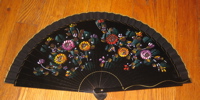It’s hot here in New York in the summer. Hot and sticky, as if the air were filled with invisible cobwebs of cotton candy. Hence the seasonal mantra of the New York City weatherman, translated from the sticky Latin of our municipal motto, “Hazy, hot, and humid.”
So I carry a fan. At the moment, it’s a relatively nice painted wooden one that’s far more effective and more durable than the cheap paper ones I used to get. I use it primarily when riding the bus and the subway. Both modes of transit are reliably air conditioned these days, but the fan amplifies the A/C’s effectiveness by assisting in the rapid evaporation of sweat, of which I produce more than I used to, thanks to a medication I’m on. The other passengers look at me oddly at first and eventually enviously, but I’m only rarely asked where to get a fan, and I never see anyone else using one. Do other people fear to resemble a southern belle or a Chinese mandarin? It doesn’t bother me, I’d rather be cool.
That pretty much sums up the traditional science fiction type: careless of convention and more than happy to look eccentric to achieve a practical advantage.
Perhaps it’s not true anymore, but for decades there really was such a science fiction type, and not only among the genre’s readers. For people of that type (originally men, but eventually women, too) were overwhelmingly its writers, artists, and editors.
[click on “Read more…” to uh, read more!]
OK. So here’s a list. What do these ten men have in common?
- Arthur C. Clarke
- Christopher Priest
- Donald A. Wollheim
- Frederik Pohl
- Harlan Ellison
- Isaac Asimov
- Ray Bradbury
- Robert Bloch
- Robert Silverberg
- Terry Carr
Well, obviously, they are some of the greatest names in 20th century science fiction. Less obviously, they were all active SF fans before they became professionals. Yes, that’s right, every one of them was once one of those nice but nerdy boys who attend club meetings, publish fanzines, and go to conventions. They were immersed in SF and fantasy long before they began to write it. SF was their religion, and they grew up to become its high priests.
This doesn’t seem to be happening any more. (Why, is a question for another time.) My colleague Patrick Nielsen Hayden and I are from what is perhaps the last generation to follow that path from the wilds of fandom to the halls of professional publishing. We don’t usually harp on it, nor are we ashamed of it. We are, possibly, a little proud.
It is now 82 AG (after Hugo Gernsback founded Amazing Stories), and even here in that same 21st century future that Amazing’s readers dreamed of and had such high hopes for, there is still a remarkably smooth continuum from the ranks of casual readers, through to the fans in the trenches publishing the zines and blogs and putting on the cons, and on to the studios of the artists and the offices of the writers and editors and publishers. There is still a rare osmosis, a fluid interchange among all the members of the SF/fantasy community that is unmatched in any other field of literature. (Why that should be, is again, a topic for another time.) Tor.com is but the latest manifestation of something special about our field. The medium may be new, but the energy behind the messages is the same. Open books encourage open minds. (Especially if the books are science fiction.) And open minds are the only perpetual motion machines we’re ever going to find. They spark and fizz and snap like Tesla coils.
We’re glad you could join us in a demonstration of that ongoing and, we hope, permanent, state of affairs.










